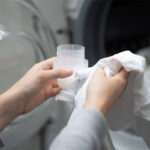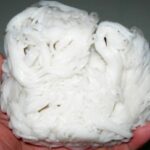Modern appliances, such as washing machines, have undoubtedly revolutionized household chores and brought convenience to our lives. But with great power comes great responsibility – or in this case, some questions about proper usage. One common query: Should you keep the washing machine door open or closed after taking out the laundry?
To Open or Not to Open: That is the Question
The washing machine is an essential appliance in any household, but many people are unsure of what to do after removing the freshly cleaned clothes. Some people immediately shut the door to prevent dust and dirt from getting in, while others leave it open to air out the machine and prevent mustiness. However, neither of these methods is entirely correct.

After a cycle, it’s crucial to open the washing machine door to allow ventilation and drying. If you look through the glass door, you’ll often see droplets of water covering the surface. Failing to wipe this moisture away promptly can lead to dampness inside the machine, promoting mold and mildew growth and potentially shortening its lifespan.
The correct course of action is to use a clean, absorbent cloth to thoroughly dry the interior of the washing machine, especially the rubber gasket and liner of a front-loading machine. These parts prevent water from leaking out of the drum during washes.
However, the rubber gasket can also hinder air circulation, trapping moisture and detergent residue. If not cleaned properly, this environment becomes a breeding ground for mold and bacteria, resulting in musty-smelling clothes and potential skin irritations from laundry that hasn’t been adequately sanitized.
Once you’ve dried the interior, it’s advisable to leave the washing machine door open for approximately two hours to ensure complete ventilation and evaporation of any remaining moisture, thus inhibiting mold growth.
Why not keep the door open for longer than two hours? Well, it’s all about balance. Leaving the door ajar for an extended period increases the chances of dust and dirt entering the machine, and it also puts strain on the door’s connection points, which can reduce the appliance’s longevity.

For households with limited space, fully opening the washing machine door might obstruct movement. A simple solution is to prop the door open just enough to allow for adequate airflow without causing any inconvenience.
Research has shown that stubborn bacteria can develop in washing machines within three months of use. If you detect an unpleasant odor coming from your machine, it’s a telltale sign that it’s time for a deep clean. Otherwise, you risk transferring bacteria to your clothes, which can then affect your health.
How to Clean a Top-Loading Washing Machine
The frequency of cleaning your washing machine will depend on how often it’s used. As a general rule, it’s recommended to give your machine a good cleaning every three to four months. For busier households or laundromats, this interval might be as short as one to two months.

– First, ensure that you’ve removed all laundry from the machine. Then, set your washer to the warmest temperature setting and the largest load size, or manually fill the drum with warm water if your machine doesn’t have these options. Check your washing machine’s manual to ensure it can handle warm water, as some plastic components may warp or damage.
– Next, add two cups of distilled white vinegar to the water and let the mixture sit for about an hour, keeping the lid closed.
– Select the longest wash cycle and let the machine agitate for a few minutes, then pause the cycle. Using a clean sponge or cloth, wipe down the inside of the drum, door, and gasket, making sure to reach all nooks and crannies.
– Prepare a solution of warm water and bleach (following the package instructions for dilution) and pour it into the drum. Let this mixture sit for about an hour, using this time to wipe down the exterior of the machine with a soft cloth.
– Finally, restart the wash cycle and let the machine complete a full cycle.
According to Xe và thể thao
“The Creative Kid and the Pepper Shaker”
Introducing a revolutionary approach to laundry – the power of black peppercorns! You may be wondering, why add black peppercorns to your laundry routine? Well, these tiny powerhouses pack a punch when it comes to enhancing your washing experience. Imagine your clothes emerging from the washer, not only clean but also invigorated and refreshed. That’s the magic of black peppercorns!
The Secret to Detecting Chemically-Enhanced Noodles Lies in a Few Drops of This Magic Fish Sauce
Introducing a unique and effective way to identify clean and chemical-free rice noodles. While we often rely on visual cues to determine the quality of rice noodles, there is a clever trick that utilizes fish sauce. This simple yet ingenious method will revolutionize the way we assess the freshness and safety of our favorite delicacy.






































